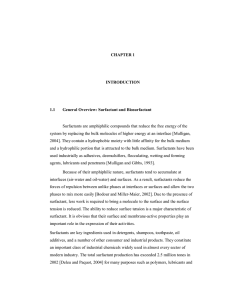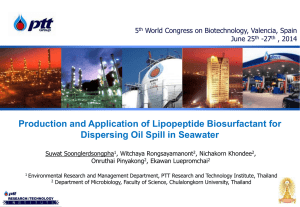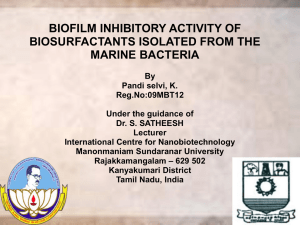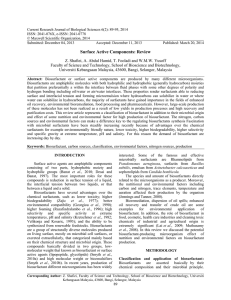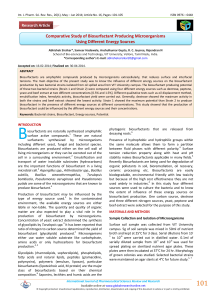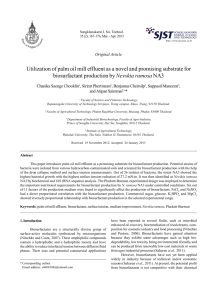07 Biosurfactant production Li Zhe Wong
advertisement
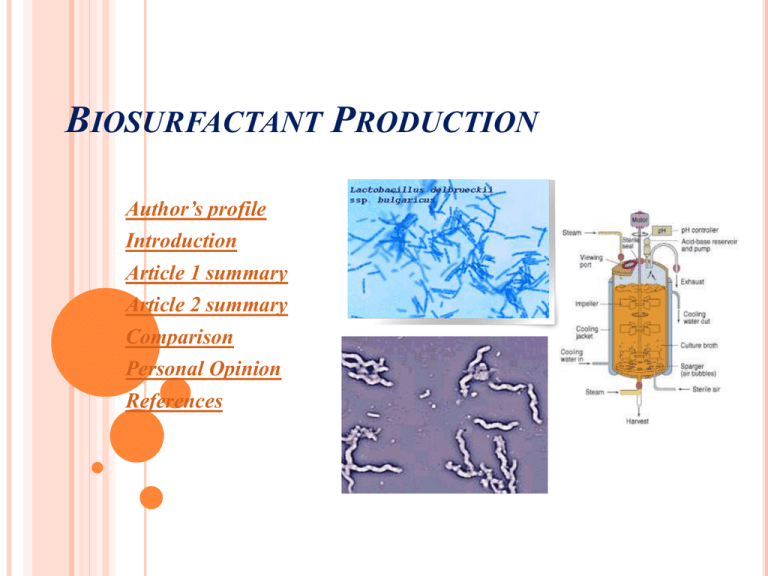
BIOSURFACTANT PRODUCTION Author’s profile Introduction Article 1 summary Article 2 summary Comparison Personal Opinion References AUTHOR’S PROFILE Hey guys, I am Li Zhe Wong, a third year student undertaking a double major in Biotechnology and Molecular Biology with a minor in Infection and Immunity. I choose this topic because I am amazed with how microbes can produce biosurfactant with the use of alternate carbon source to clear up the oil spills that occur in the vast area of the oceans. Back to Overview Introduction INTRODUCTION Oil is like chocolate. It’s dark brown and gooey (Emily and Voigt, 2011). Pollution caused by petroleum hydrocarbons in terrestrial and aquatic environment leads to significant ecological and social problems (Thavasi et al., 2011). (pict.) Biodegradation in aquatic environment is limited by the availability of nutrients (nitrogen and phosphorus) which are necessary for microbial growth (Thavasi et al., 2011). Biosurfactant produced by microbes is the solution to oil spills. Biosurfactants have not been employed in industry due to the relatively high production costs (Thavasi et al., 2007). Alternative cheaper substrates for biosurfactant production have been used. The aims of the following papers are to determine which microbes and substrates are most effective in producing the biosurfactant. Back to overview Article 1 Summary BIOSURFACTANT Biosurfactants are surface active organic compounds produced by bacteria (Thavasi et al., 2007). Applications of biosurfactant includes excellent detergency, emulsification, microbial enhancement, resource recovering (oil) which make surfactants substitute with some of the most versatile process chemicals. Biosurfactants have the ability to rapidly emulsify the oil and therefore facilitate fast microbial growth. Advantages of biosurfactans includes low toxicity , biodegradability and ecological acceptability. Most known biosurfactants are glycolipids (Thavasi et al., 2007). Problems: Limited yield (productivity), batch process and substrate inhibition could occur. Back to overview Introduction ARTICLE 1 SUMMARY Application of biosurfactant produced from peanut oil cake by Lactobacillus delbreuckii in biodegradation of crude oil (Thavasi et al., 2011). Background: Biosurfactants are surface active compounds produced by microorganisms. It received considerable attention in environmental bioremediation processes. However, it has not been used extensively due to the high cost production rate. In order to overcome this barrier and enhance biosurfactants production by microbes, alternate carbon sources (peanut oil cake) has been used. The aim of this papers was to investigate the biosurfactant production by Lactobacillus delbrueckii. Finding and Discussions: Biosurfactant production was carried out in a 3L fermentor. L.delbrueckii was cultured with mineral salts medium and peanut oil cake as the carbon source. (cont.) Conclusion: Biosurfactant produced by L.delbrueckii using peanut oil cake has showed its potential to be used in bioremediation process. Back to overview Article 2 Summary DISCUSSION CONT. It was noted that biosurfactant production by L.delbrueckii with the use of peanut oil cake generates 5.35g/l of biosurfactant (figure 1) as compared with the use of cheese whey and malasses where they only obtained 1.45g/l and 1.7g/l respectively. This indicated the potential use of peanut oil cake as a renewable cheaper carbon source for biosurfactant production. Back to overview Article 1 Summary ARTICLE 2 SUMMARY Biosurfactant production by Corynebacterium kutscheri from waste motor lubricant oil and peanut oil cake (Thavasi et al., 2007). Background: Biosurfactants are promising natural surfactants that offer several advantages over chemically synthesized surfactants. The reduction of the production costs of microbial biosurfactants requires a selection of inexpensive culture media as they constitute 50% of the total production costs. The aim of this study was to demonstrate the production of biosurfactant by Corynebacterium kutscheri using waste motor lubricant oil and peanut oil cake. Findings and discussions: Biosurfactant production was carried out in 3L fermentor using waste motor lubricant oil and peanut oil cake as carbon source. Corynebacterium kutscheri was isolated from sea water sample and was cultured in mineral medium. (cont.) Conclusion: Biosurfactant production by Corynebacterium kutscheri with the use of waste motor lubricant oil and peanut oil cake suggested the possibility of industrial production of biosurfactants using economically cheaper carbon source. Back to overview Comparison DISCUSSION CONT. From the results, it was observed that with the use of waste motor lubricant oil as a carbon source, the maximum biosurfactant production by C.kutscheri was 3.85mg/ml (figure 1). The results differ when peanut oil cake was use instead where the maximum biosurfactant production by C.kutscheri was 6.4mg/ml (figure 2). Back to overview Article 2 Summary COMPARISON Pollution caused by petroleum hydrocarbons in aquatic and terrestrial leads to severe environmental degradation (Thavasi et al., 2011). The use of chemical surfactants as remediating agents is not favorable due to their toxic effects on the existing biota in the polluted area. Therefore, a successful bioremediation of oil spills environment still remains as a challenge for the scientists. Biodegradation in aquatic environment by microbial processes is limited by the nutrient availability which are essential for the growth of the microbes. Alternate method to overcome barrier - biosurfactants. The articles chosen describe the various carbon sources and bacteria used to achieve a maximum biosurfactant production . Article 1 is a study based on the bacteria Lactobacillus delbrueckii cultured with peanut oil cake as the carbon source yielded 5.35mg/ml of biosurfactant production. Article 2 is a study based on the bacteria Corynebacterium kutscheri cultured with peanut oil cake and waste motor lubricant oil as the carbon source yielded 6.4mg/ml and 3.85mg/ml respectively. Back to overview Similarities SIMILARITIES Several similarities could be noted throughout the both articles. Both articles report the production of biosurfactant when peanut oil cake is used as a carbon source for both of the bacteria. Both articles report the ability of the biosurfactant produced to emulsify a diverse range of hydrocarbon pollution. Back to overview Differences DIFFERENCES One of the major differences is the use of bacteria to produce the biosurfactant. In article 1, the production of biosurfactant involves the use of Lactobacillus delbrueckii while the bacteria use in article 2 was Corynebacterium kutscheri. The other differences between the two articles is the use of waste motor lubricant oil as one of the carbon source to test the production of the biosurfactant in article 2. The use of Corynebacterium kutscheri with peanut oil cake as a carbon source seems to be more effective in producing the biosurfactant as compare to the Lactobacillus delbrueckii when the same carbon source (peanut oil cake) is being supply. Back to overview Personal Opinion PERSONAL OPINION The removal of the hydrocarbon pollution in the vast area of the oceans with the application of biosurfactants seems to be a promising solution. This is further enhance by the production of biosurfactant using microbes with the supply of cheaper carbon source – peanut oil cake. I personally feel that this is very interesting where scientists use different approaches/alternatives in researching a cheaper carbon source to feed the microbes in order to allow the microbes to grow rapidly and at the same time to produce biosurfactants. Back to overview References REFERENCES Bharali. P., Das. S., Konwar. B.K and Thakur. A.J. (2012). Crude biosurfactant from thermophilic Alcaligenes faecalis: Feasibility in petro-spill bioremediation. International Biodeterioration & Biodegradation 65, 682-690. Cameotra. S.S and Makkar. R.S. (2010). Biosurfactant-enhanced bioremediation of hydrophobic pollutants. Pure Application Chemistry 82, 97-116. Emily and Voigt. (2011). Invasion of the Oil-Eating Microbes. Odyssey 20, 16-18. Thavasi. R., Jayalakshmi. S. and Banat. I.M. (2011). Application of biosurfactant produced from peanut oil cake by Lactobacillus delbrueckii in biodegradation of crude oil. Biosecure Technology 102, 3366-3372. Thavasi. R., Jayalakshmi. S., Balasubramanian. T. and Banat. I.M. (2007). Biosurfactant production by Corynebacterium kutscheri from waste motor lubricant oil and peanut oil cake. Letters in Applied Microbiology 45, 686-691. Back to overview Youtube Movie FURTHER INFORMATION Physiological and biochemical characteristics of C.kutscheri: Back to overview Article 2 Summary Oil Slick, Alaska Oil shimmers among rocks on Alaska's North Slope, a region where rich reserves of both wildlife and hydrocarbons have led to pitched battles between environmentalists and petroleum interests. Oil spills wreak havoc on coastal plants and marine animals. But high-profile incidents, such as the 1989 Exxon Valdez accident in Alaska, tend to focus public attention on the issue of ocean pollution. Single-hulled oil tankers were outlawed in the U.S. after that devastating spill. Obtained from: http://ocean.nationalgeographic.com/ocean/pho tos/ocean-pollution/ Next Exxon Valdez Oil Spill A pool of saffron-colored oil paints swirls along Alaska's shoreline following the ExxonValdez oil spill in 1989. Although it was not large compared to other spills, the Valdez oil spill was one of the world's most ecologically devastating disasters, spoiling more than 1,200 miles (1,931 kilometers) of shoreline, including three national parks, three national wildlife refuges, and one national forest. Obtained from: http://ocean.nationalgeographic.com/ ocean/photos/ocean-pollution/ Next Fishermen Confront Oil Spill Fishermen confront oil-slicked waters in Eleanor Bay, Alaska, days after tanker ExxonValdez disgorged nearly 11 million gallons (41,640 kiloliters) of oil into Prince William Sound. The 1989 event is the worst oil spill in U.S. history and hurt generations of wildlife including salmon, sea otters, seals, and sea birds. Obtained from: http://ocean.nationalgeographic.com/oc ean/photos/ocean-pollution/ Next Oil-Coated Crab, Lebanon With the area's preponderance of fossil fuel-related commerce, the semi-enclosed Mediterranean Sea is particularly susceptible to oil spills. International animosities in the region aggravate the problem. This crab is negotiating an oilfouled beach polluted when Israeli planes bombed a power station in Beirut, Lebanon, in 2006. Obtained from: http://ocean.nationalgeographic.com/o cean/photos/ocean-pollution/ Introduction All obtained from: http://www.google.com.au/search?q=fermenter+ima ges&hl=en&prmd=imvnse&tbm=isch&tbo=u&sour ce=univ&sa=X&ei=MW93UOTvJsefiAfnoIHQAg &ved=0CB4QsAQ&biw=1680&bih=869 Back to overview Article 1 Summary Cleaning Oil Spills by Biodegradation OTI’s products are made of natural components. Benefits: OTI’s products nor the resulting substances from biodegradation are toxic. OTI’s products are the first products offered worldwide based on true biological degradation. Obtained from: http://www.youtube.com/watch?v=wNiC cW8Ama0
